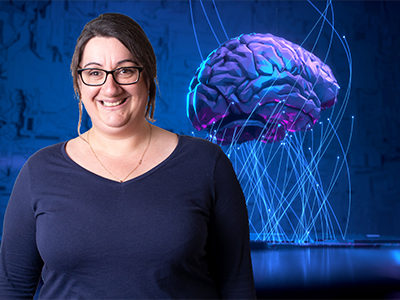Can we bring artificial intelligence and machine learning to the frontline?

Our warfighters are bombarded with an ever-expanding smorgasbord of actionable, rich and diverse tactical information.
On-board sensors on a multitude of platforms are generating intelligence, surveillance and reconnaissance data streams that, if processed, can provide the warfighter with the tactical advantage.
But that “if processed” is a big if, according to defence scientist Dr Angela Consoli. She has been awarded a fellowship at DSTG that gives her three years to focus on how artificial intelligence (AI) and machine learning (ML) can be introduced to help warfighters consume the data smorgasbord without heartburn.
AI at the centre of future warfighting
Dr Consoli’s research is of particular interest as our warfighters come up against an array of smart, intelligent and asymmetric threats, where traditional methodologies are proving to be less-and-less effective. She believes human/AI augmentation is critical for the future of ADF warfighting.
“We need a paradigm shift toward AI-centric warfare to cope with the amount of tactical information now being generated,” she says. “I’ll be focusing on ways Defence can augment its tactical systems with AI to give Australian warfighters a tactical edge. Most of the AI in current Defence systems is implemented at the operational layer, away from the warfighter. The question I’ll be answering is — how do we use AI/ML to help our warfighters by giving them the best information and decision superiority?”
Dr Consoli has been fortunate to have been able to continue her university PhD research at DSTG. Her thesis dealt with how to enhance coordination and cooperation techniques with AI to improve team automation. She emphasises that this research is not about developing killer robots. “You can thank Hollywood for that fear,” she says. “Military platforms at the moment struggle to have any AI in them. It’s very early days for AI on the front line.”
According to Dr Consoli, our warfighters need systems that support them in selecting the best course of action at that moment in time — the quickest and best decisions in order to save their lives while also assuring mission objectives. “I’m talking about getting to the point where we have the ability to collect the situational information, process and assess the information, and then not only represent it but also make inferences and point out relationships that exist in that data. That’s what we call reasoning, and that’s the next big step after learning.”
A reasonable path forwards
“Machine learning gives you the ability to classify and to identify and make the data a lot more trustworthy. But how does the software go beyond that, to identify relationships and make inferences in what it is seeing?”
The first challenge is getting the AI into the Defence system, integrated and augmented with the human, and trusted by the human. Much work is being done in this area of trust. “Currently human/AI teaming relationships are sharply partitioned. The endpoint we are heading towards is augmentation such that in the final analysis, it won’t be clear who has processed the information and made the inference.”
According to Dr Consoli, that step from structuring data to inferring relationships is the hard part for AI because it’s a much higher cognitive construct and machines are inherently rules-based.
Collaboration will be a key
In line with Defence’s new science and technology strategy More, together, a major priority for Dr Consoli will be outreach and partnering across Defence, academia and industry to harness the best of human and computer sciences.
“For us to ensure we can transition outcomes from S&T to capability it’s really important for AI that we work with defence industries and with Defence end users. Initially, I’ll be looking at what machine reasoning is for Defence, and translating what we already know in AI/ML into the military platform representations that we have here at DSTG.”
Over the course of the next few years, by drawing on the best of cutting-edge research in computational intelligence and cognitive science, Dr Consoli aims to develop machine learning algorithms to extract and contextualise unstructured tactical information.
“I’ll be developing a machine reasoning engine to perform higher-levels of information fusion to better detect and identify threats through behaviour so as to predict their intent.”
Cognitive enhancement and augmentation is one of the focus areas up for discussion at the 2020 Defence Human Sciences Symposium (DHSS). DHSS 2020 is a three-day online event co-hosted by DST and Deakin University.
Dr Consoli’s fellowship research will contribute to the Agile C2 and Information Warfare STaR Shot, part of the Defence S&T Strategy More, together.

